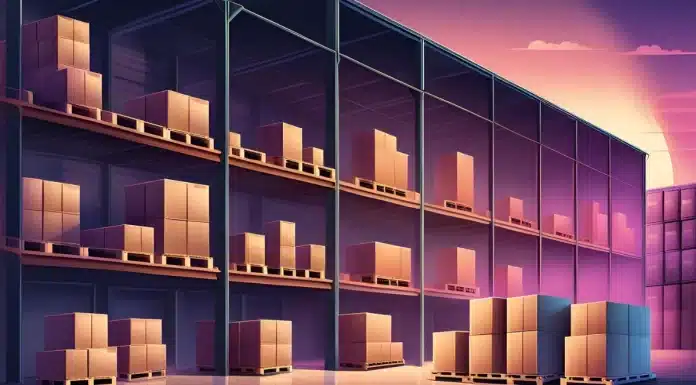Warehouse distribution is one of the biggest challenges for any growing online business. Traditional methods, like managing inventory with spreadsheets, often lead to inefficiencies and missed opportunities.
New warehouse distribution technologies are changing the game, allowing businesses to streamline operations, reduce errors, and optimize storage. Smart warehousing isn’t just about storage; it’s about improving every step, from order fulfillment to delivery.
Imagine having real-time control over your inventory, meeting customer demands seamlessly, and reducing costs. With the right warehouse distribution system, these goals are entirely within reach.
Read on to learn how advanced warehouse distribution works, the benefits it offers, and how it can support your business growth.
Key Takeaways
|
What is a Warehouse Distribution?
A warehouse is often seen as a large building filled with shelves of products, but it’s more than just a storage space.
Warehouse distribution involves storing goods and managing their movement to fulfill orders efficiently. This process includes receiving products, organizing them, picking and packing orders, and shipping them to customers or retail locations.
Different than wholesale distribution which utilizes wholesale distribution software and focuses on selling bulk orders, warehouse distribution utilizes a warehouse management system and focuses on storing and managing the existing stock.
In the past, businesses stored products in warehouses before sending them to retail stores or wholesalers. Today, companies in Singapore use e-commerce platforms like Shopify and Lazada, as well as marketplaces like Shopee and Qoo10.
As e-commerce grows, warehouse distribution is more important than ever. It helps reduce delivery times, speeds up shipping, and keeps inventory under control—all while managing costs effectively.
Hashy AI Fact

Need to Know
AI for Warehouse Management Systems (WMS) enhances efficiency by enabling predictive stock management, allowing businesses to stay ahead of demand while maintaining cost control and fast delivery.
Request a free demo today!
What is a Distribution Center?
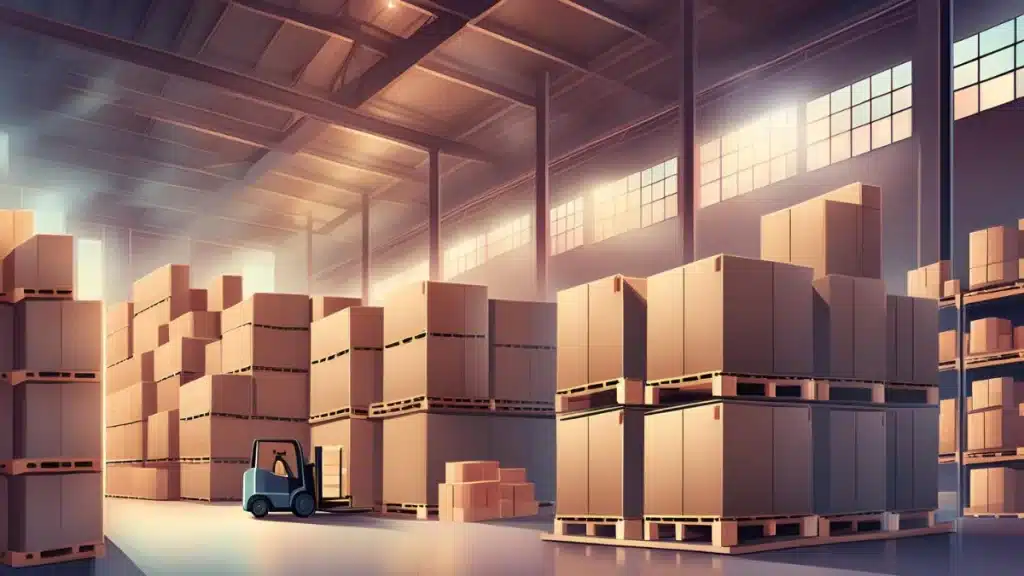
A distribution warehouse, or distribution center, is a specialized facility where ready-to-sell inventory is stored until it’s time for order fulfillment. Unlike traditional warehouses, these centers focus on short-term storage and fast inventory flow, with goods quickly moving to retail locations or directly to customers.
Distribution centers (DCs), cross-dock facilities, or fulfillment centers, are not just storage spaces. They handle order processing, packing, and shipping. Some even perform light assembly, quality control, and repackaging to complete orders.
Supported by Warehouse Management System (WMS) or inventory management systems, distribution centers track inventory and productivity across multiple locations in real time.
Difference of Warehouses and Distribution Centers
The evolution of supply chains has made the distinctions between traditional warehouses and distribution centers more apparent, despite some considering them to be merely semantic.
While both serve as hubs for receiving, storing, managing, and distributing goods, they fulfill different roles in the supply chain.
Here are several key differences between warehouses and distribution centers:
- Primary function: Warehouses mainly store products for extended periods until needed, ideal for businesses managing seasonal fluctuations or bulk purchases. Distribution centers, however, go beyond storage—they handle product mixing, cross-docking, order fulfillment, and packaging, catering to the rapid movement of goods.
- Flow of goods: Products typically sit for longer durations in warehouses. Distribution centers have a faster turnover, quickly moving goods to stores or customers, acting as a bridge between suppliers and consumers.
- Order processing: Distribution centers play a vital role in fulfilling retail and eCommerce orders, using advanced technology like Automated Storage and Retrieval Systems (ASRS) and Warehouse Management Systems (WMS). Warehouses, on the other hand, focus more on storing goods and have fewer intricate functions.
- Strategic location: Distribution centers are often located near transport hubs, highways, and urban areas to facilitate quick distribution, meeting the demand for same-day or next-day deliveries. In contrast, warehouses may not require such strategic placement.
- Customers and technology: Distribution centers often serve specific eCommerce and direct-to-consumer (DTC) businesses, employing cutting-edge technology to manage inventory and streamline operations. Warehouses usually cater to long-term storage needs and may not have the same level of technological integration.
Despite these differences, both warehouses and distribution centers remain essential to the supply chain, supporting long-term and short-term storage to meet varying business demands.
Benefits of Technology in Warehouse Distribution
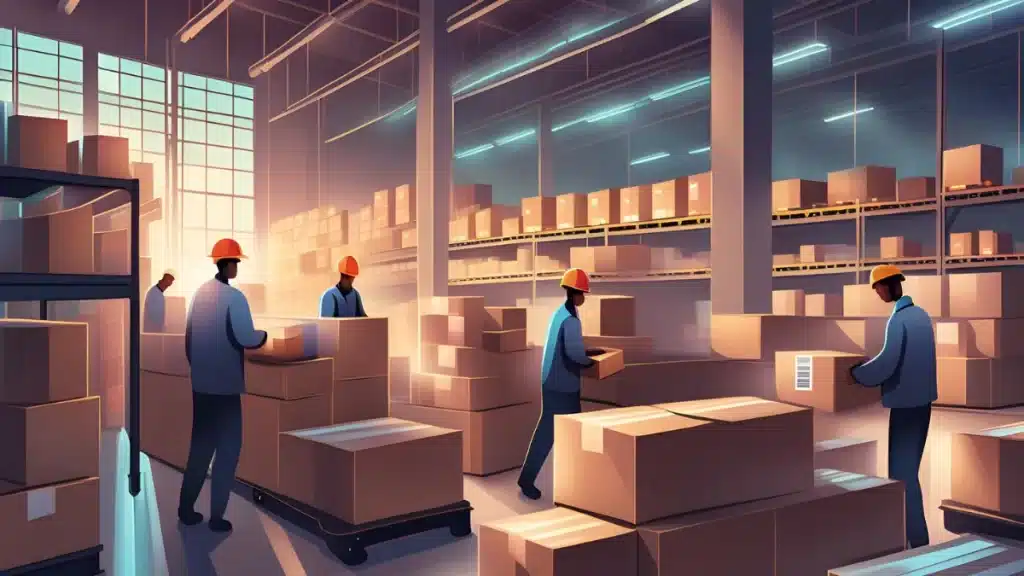
Warehouses’ distribution now uses the latest technology to enhance accuracy, productivity, and inventory flow. Smart warehousing has become the new standard, optimizing inventory to meet demand at each location.
One essential tool in this system is barcode tracking software, which helps businesses track products in real-time, reduce errors, and improve overall warehouse efficiency.
It also reduces risks like picking errors, inventory shrinkage, and slow fulfillment. Here’s how technology plays a role in warehouse distribution:
- Cost savings: Reducing labor costs, minimizing errors, and optimizing space use can significantly lower warehouse operating expenses. Deloitte study notes that Industry 4.0 technologies enable warehouses to handle more products in the same space, further cutting costs.
- Improved efficiency: Technologies like Warehouse Management Systems (WMS) and automated storage and retrieval systems streamline tasks such as inventory management, picking, and packing.
- Increased productivity: Mobile robots (AGVs and AMRs) and picking tools help workers complete tasks faster. BCG reports that automating warehouse networks can improve service levels by 20% to 50% and reduce fulfillment costs by 25% to 50%.
- Enhanced accuracy: Automated tools like barcode scanners and RFID technology reduce human errors in inventory tracking and order fulfillment. MDPI’s research indicates that IoT implementation in warehouses can increase operational efficiency by 20% to 30%.
- Real-time data and visibility: Automation provides real-time updates on inventory levels, product movement, and order status, enabling better decisions and improving supply chain visibility. McKinsey survey states that 70% of logistics executives plan to invest approximately $100 million in automation in the next five years.
- Better space utilization: Advanced storage solutions and automated systems make the most of available space, allowing warehouses to store more products in the same area.
With these benefits, it’s clear that the right WMS can transform your warehouse distribution. Curious about how much a tailored solution might cost? Use our pricing calculator to explore a customized quote and see how affordable optimization can be.
Challenges of Traditional Warehousing
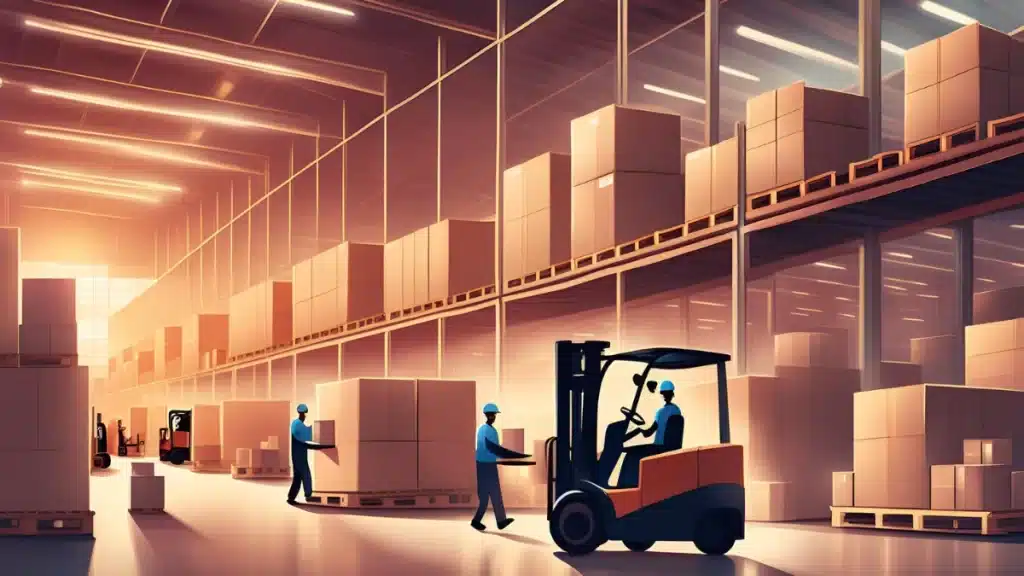
Traditional warehousing comes with several challenges that can impact efficiency and customer satisfaction. Addressing these issues is crucial for maintaining smooth operations and meeting market demands. Here are the key challenges faced by traditional warehousing practices
1. Limited control and visibility
Without real-time visibility and control of warehouse operations, tracking inventory and managing resources becomes difficult. This lack of insight hinders a company’s ability to respond promptly to market changes.
Using integrated management systems and adopting new technologies can enhance warehouse distribution control and responsiveness.
2. Minimizing long-distance shipping
Delivering goods over long distances can be both expensive and time-consuming. Companies often struggle to find cost-effective ways to handle these expenses while ensuring timely deliveries.
Optimizing transportation routes, using strategically located warehouses, and implementing advanced logistics technologies can help reduce transit time.
3. High costs of in-house fulfillment
Managing fulfillment operations internally requires a significant investment in infrastructure, technology, and workforce. This leads to high overhead costs, difficulties in scaling operations, and challenges in adapting to changing market demands.
Outsourcing fulfillment to specialized logistics providers can offer a more flexible, scalable, and cost-effective solution.
4. Labor and space limitations
Efficient warehouse distribution depends on adequate staffing and sufficient space. Many companies face challenges in hiring skilled workers and expanding physical space as their business grows, leading to bottlenecks in the fulfillment process and affecting overall efficiency and customer service.
5. Common warehouse problems
Issues like inventory errors, shipping inaccuracies, and fulfillment delays are often due to outdated warehouse management practices. These problems can lead to customer dissatisfaction and potential revenue loss.
Addressing these challenges requires robust inventory management, intelligent order processing, and responsive customer service.
6. Customer dissatisfaction from slow delivery
Customers now expect faster delivery time. Delays in shipping can result in unhappy customers and damage a brand’s reputation. Streamlining fulfillment processes and using efficient distribution networks are key to ensuring timely delivery and maintaining customer satisfaction.
Best Practices of Warehouse Distribution
Effective warehouse distribution relies on smart practices to keep operations smooth and efficient. Following these best practices can optimize inventory flow from clunky, traditional practices to quicker and more reliable methods.
Let’s look at the key steps to enhance your warehouse distribution process:
-
- Regularly Review SKU Velocity: Continuously assess SKU velocities to identify products that have shifted from fast to slow-moving (or vice versa). Keep high-demand SKUs in easily accessible locations to optimize order fulfillment.
- Use Bins and Totes for Storage: Utilizing bins, dividers, and totes helps keep products clean and organized while maximizing storage space and ensuring items are in good condition.
- Implement a Pick-and-Pass System: Have order totes move through different zones for fulfillment, with each picker responsible for filling SKUs only within their designated zone before passing the tote to the next.
- Batch Picking for Faster Fulfillment: Batch picking enables a single worker to handle multiple orders at once, reducing the need for repeated trips to the same pick locations throughout the day.
- Adopt Parallel Picking: Assign pickers to specific zones, allowing them to pick SKUs within their area. This strategy speeds up order fulfillment by processing more orders at the same time.
- Create a Vendor Compliance Program: Establishing a vendor compliance program can simplify warehouse distribution, reduce handling times, improve transportation services, and boost customer satisfaction.
- Implement a WMS: A Warehouse Management System (WMS) simplifies operations by tracking inventory in real-time, optimizing storage, and managing order fulfillment. It reduces errors, increases picking accuracy, and gives you clear insights into stock levels, allowing for smarter, data-driven decisions.
Optimize Your Warehouse Distribution with HashMicro WMS
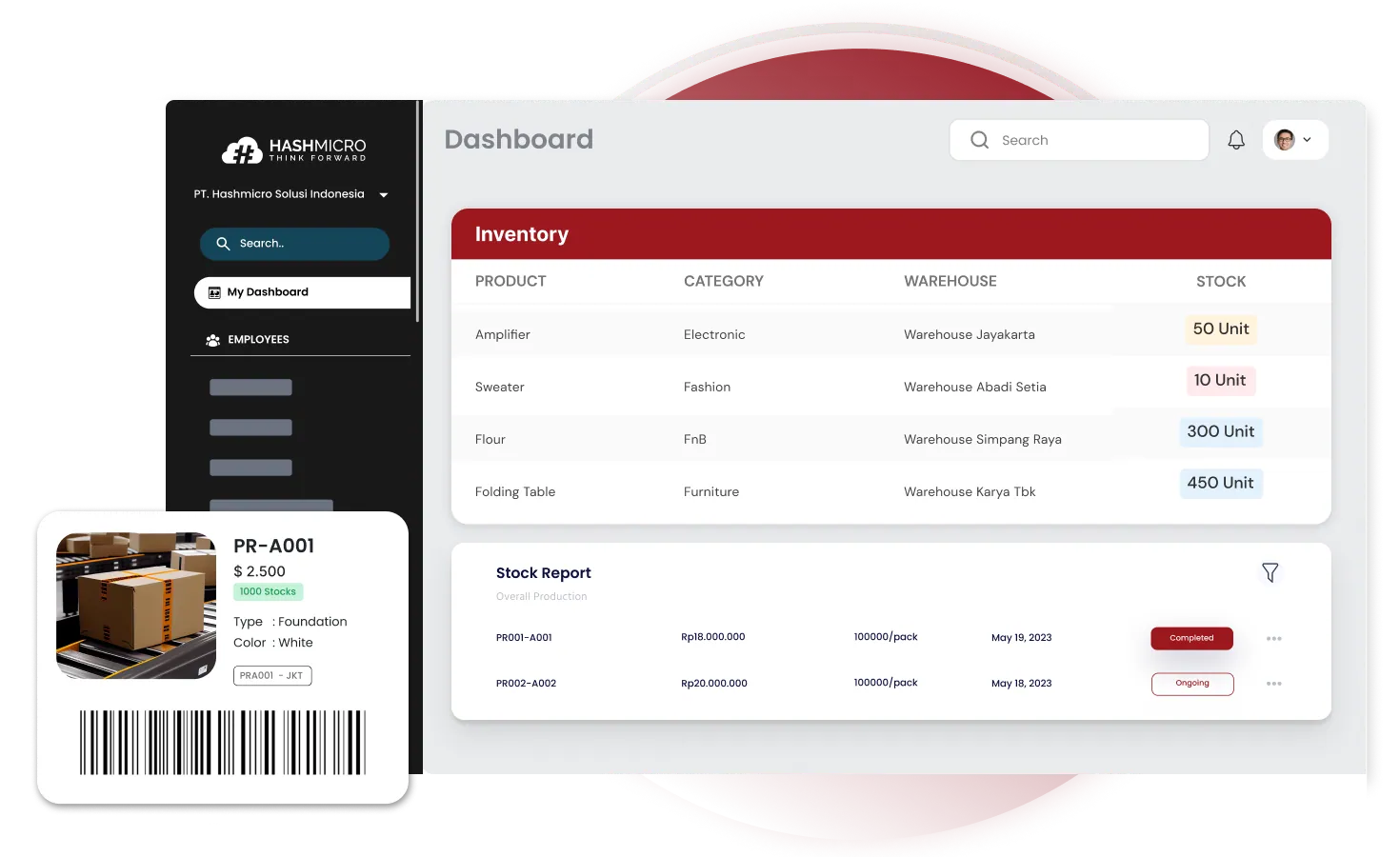
Incorporating the right technology into warehouse distribution can significantly enhance safety and efficiency. Don’t go siao trying to track stock manually. Let the WMS do it for you! One of the best WMS in Singapore, which is entirely user-centric, is HashMicro’s warehouse management system.
This system goes beyond just managing inventory; it optimizes your warehouse while simplifying distribution. Over 1,750 renowned businesses, including those with complex warehouse distribution needs, trust HashMicro; it’s a proven way to streamline warehouse distribution.
These businesses have seen smoother operations, reduced costs, and better efficiency with features like real-time tracking and automated stock management. Whether handling high order volumes or optimizing space, HashMicro’s WMS adapts to suit any growing business.
For example, HashMicro’s WMS helps organize warehouse layouts for faster, safer picking. With unlimited users, it can grow alongside your business. Here’s how it does it:
- RFID Warehouse Rack Stock In-Out Automation: Tracks stock movement in and out of racks using RFID technology, ensuring real-time accuracy in inventory levels for efficient distribution. No more guesswork, everything zhun-zhun!
- 3D Warehouse: A digital model clearly shows inventory placement and storage capacity, streamlining picking and storage processes.
- Stock Forecasting: Uses past sales data and trends to predict future demand, helping you prepare the right amount of stock and avoid overstocking.
- Racking Capacity with Putaway Strategy: This strategy provides smart recommendations for placing goods when they arrive or before shipment. Optimizing rack space speeds up the picking and packing process.
- Pick, Pack, Delivery 3-Step Route: This route manages the entire process, from picking items to packing and delivering to customers. It is essential for fast, accurate order fulfillment.
Best of all, the system’s high-quality interface is intuitive and easy to navigate. It provides step-by-step guidance with visuals to help your team work more efficiently.
Conclusion
Warehouse distribution efficiently stores goods, manages their movement, and fulfills orders. It includes receiving, organizing, picking, and shipping products to customers or retail locations. As e-commerce grows, effective warehouse distribution is more vital than ever.
For businesses in Singapore, HashMicro’s Warehouse Management System (WMS) can take your warehouse operations to the next level. With features like real-time inventory tracking and smart storage solutions, it ensures your operations are always efficient and accurate.
HashMicro’s WMS is built to grow your business, offering unlimited users and advanced tools. It streamlines stock forecasting, picking, packing, and delivery—all through an easy-to-use interface. Even better, there’s a CTC-Grants offer that can save you up to 70%, making this advanced solution more affordable for businesses looking to modernize their warehouse systems.
Ready to optimize your warehouse distribution? Give HashMicro’s free demo a try today!
Warning: Undefined array key "med" in /home/hashmicr/public_html/blog/wp-content/plugins/insert-headers-and-footers/includes/class-wpcode-snippet-execute.php(419) : eval()'d code on line 281

FAQ About Warehouse Distribution
-
What is an example of a warehouse distribution?
A distribution center is a place where products are managed, stored, and dispatched to customers or retail outlets. A great example in Singapore is SingPost’s Regional eCommerce Logistics Hub, which manages tasks ranging from processing orders to shipping them out.
-
What is a distributed warehouse?
Distributed warehousing is a strategy where businesses fulfill, ship, and distribute products from several smaller, strategically located warehouses, rather than relying on one or two larger ones.
-
What are the 4 channels of distribution?
Distribution channels consist of wholesalers, retailers, distributors, and online platforms. In a direct distribution channel, manufacturers sell directly to consumers, whereas indirect channels involve multiple intermediaries before the product reaches the customer.
-
Is logistics and distribution the same?
The main difference between logistics and distribution lies in how they’re planned and structured. Logistics primarily focuses on the storage and movement of goods, while distribution deals with how products are positioned for the end user.
-
What is the role of distribution in logistics?
The role of distribution in logistics is to ensure the efficient movement of goods from producers to consumers while optimizing time, cost, and resources. Distribution involves transportation, warehousing, inventory management, and order fulfillment to ensure products are delivered to the right place at the right time. It plays a crucial role in maintaining supply chain efficiency, meeting customer demand, and enhancing business competitiveness.


